|
BULB LOG 40 --- 3rd October 2007
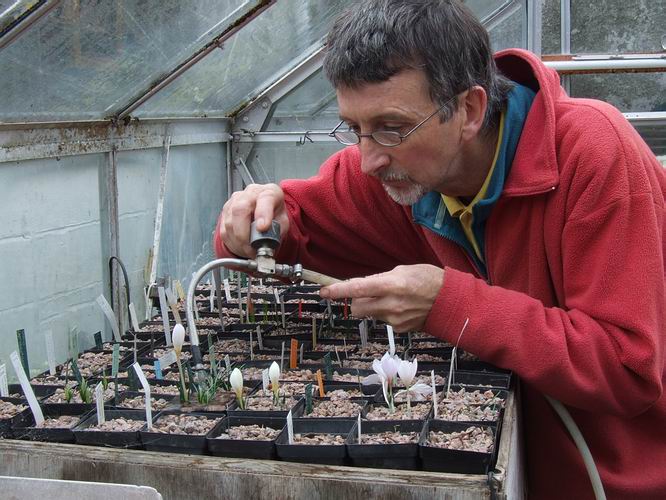
October Storm
Now October has arrived it is now time for me to apply the second storm. The procedure is just the same as for the September storm where I go round and flood every pot at least twice so I am sure the compost is wet all the way through. The only difference is that I use my smaller hose head so I can water more accurately than I can with the spray head. The reason for this is that I do not want those flowers and foliage that are in growth to get excessively wet and it also means that I scan each pot carefully to see what growth may be visible.
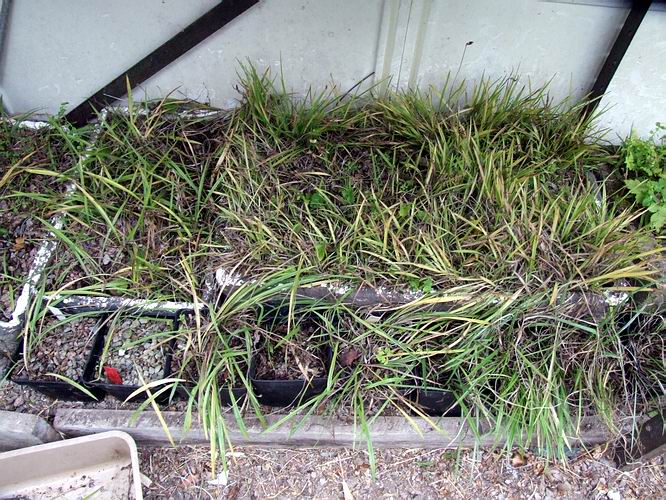
Rhodohypoxis troughs
I am taking my troughs of Rhodohypoxis troughs under cover on time this year - I usually leave it a bit too late. I find that they are perfectly cold hardy as long as they are nearly dry - if they are sitting in wet compost and we get a hard frost that combination can prove fatal.
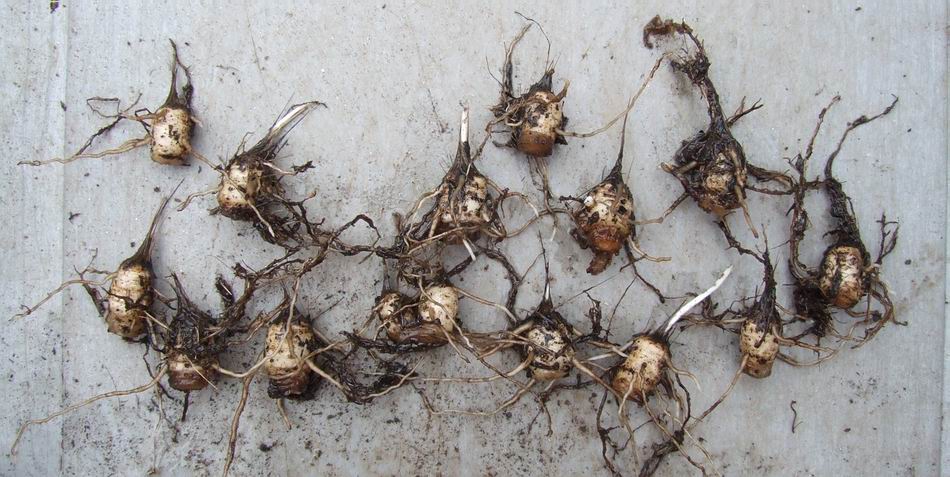
Rhodohypoxis corms
I had a look into a pot to see how the corms looked and they are very nice sized considering these were quite small last year. I can either replant these into dry compost as I will do or I know of some people who store them in paper bags in a cool dry environment. The important thing is to make sure they are dry for their winter dormancy. I should emphasise that these South African bulbs are from a climate that has dry winters and wet summers so unlike the Mediterranean bulbs they do not make roots over the winter - they stay completely dormant all winter and start into growth with the spring/summer rains. The small part at the base of each corm is what remains of last season's corm and it will slowly dry out and shrivel away. It holds a lot of moisture and if you are not careful to let it dry out it can lead to rotting of the new corm.
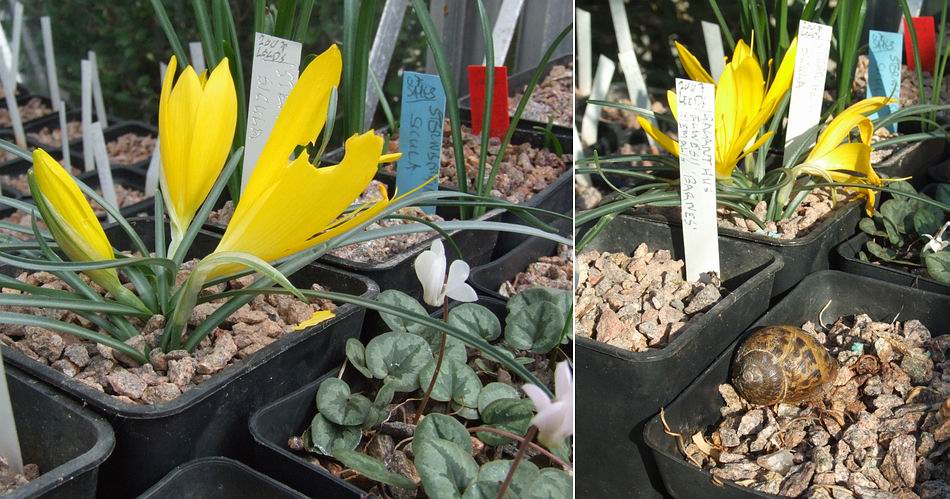
Eaten sternbergia flower
One of the flowers on the Sternbergia sicula I got from Rod and Jane Leeds has been somewhat chewed. I suspected a slug or snail so I placed a small amount of blue slug pellets around that area and next morning I found a rather large snail with a bit of a hangover so I did the humane thing!
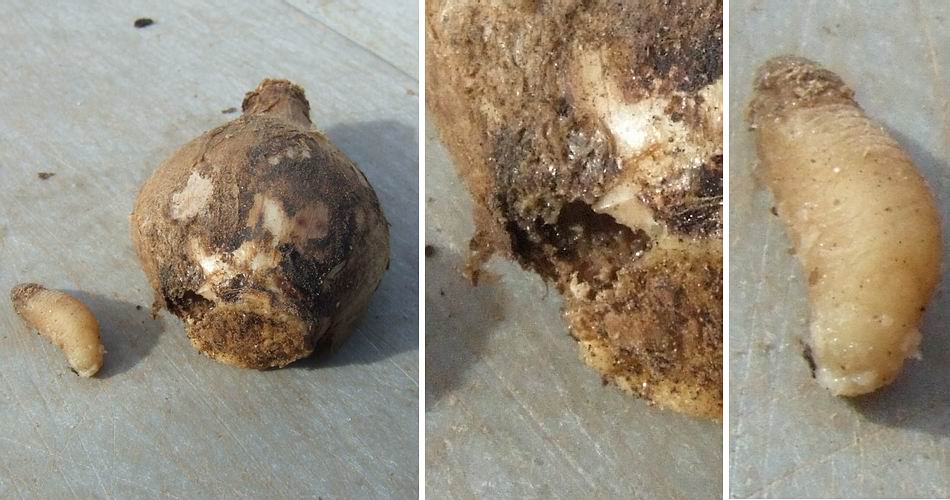
Narcissus fly maggot
Talking of things being eaten, I have never experienced Narcissus fly in our garden before this spring when I saw just one or two then today I was re-potting some narcissus bulbs that we bought in last year and noticed a small hole at the base of one of the bulbs - it was semi sealed with grains of sand. On probing I found a maggot tail protruding so I pulled on it and managed to extract the maggot - they are amazingly tough skinned as I had to pull quite hard. The mouth part of the maggot is to the bottom of the pictures.
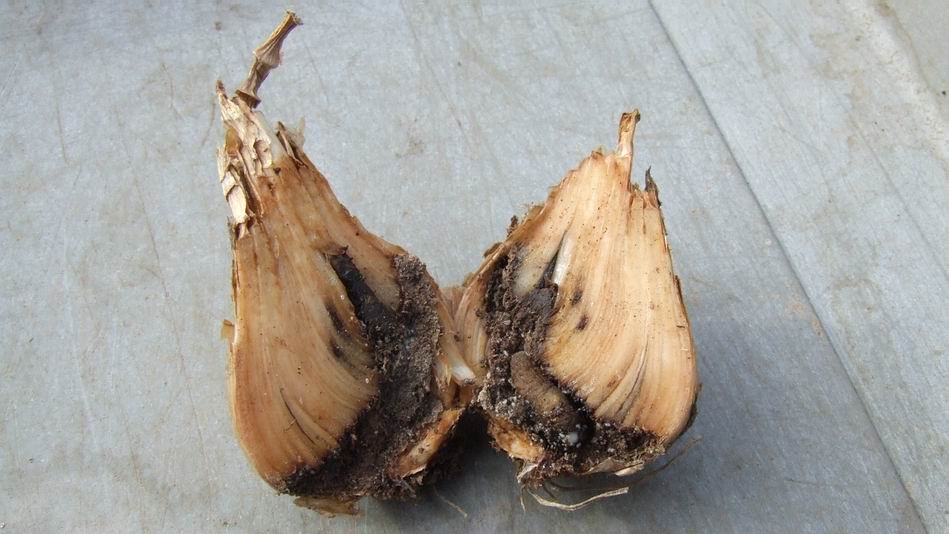
Narcissus split showing fly grub
I found another bulb with a hole but no sign of the maggot sticking out so I cut the bulb in half and found it had eaten well into the bulb. They over winter in the bulb eating their way through the scales until they pupate and emerge in the spring as a Narcissus fly. They then fly around,( I don't know whether they need to find a mate or not as many of these pestilential insects are born pregnan), until they find narcissus leaves. They are not too fussy as I understand they are also partial to Galanthus but once they find the leaves of a suitable victim they lay their eggs on the ground close to the leaves where the maggots can hatch out, burrow down to the bulb and chew their evil way in. I am never keen to buy in bulbs, preferring to raise from seeds, but I was persuaded to get some of these very nice cultivar narcissus that could not be raised from seed which I am attracted to. I will never know for certain if it is a coincidence that we have suddenly found narcissus fly in our garden or if they arrived w
ith these bulbs.
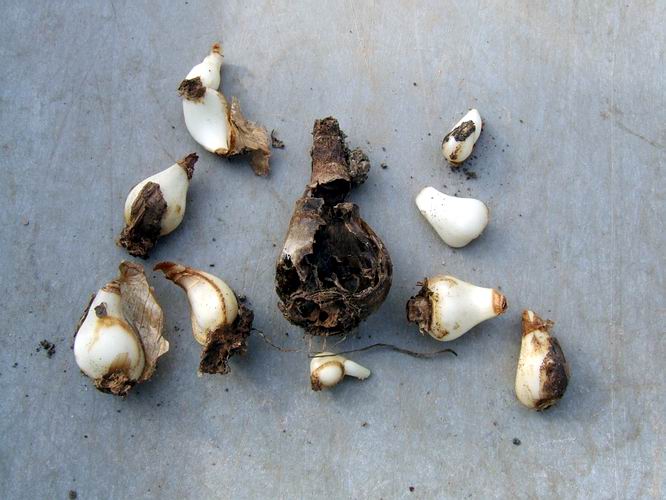
Narcissus bulb eaten by maggot
Obviously from this well eaten narcissus bulb the maggots were active last year as well and that would account for the lack of flowers in some of the pots of the bought in bulbs. It is not all bad news as nature has a way of balancing things out and it would not be a good survival method for a parasite to wipe out its food source completely. You can see from this picture that while the maggot had eaten most of the bulb there were sufficient bits left containing buds which went on to produce a number of small bulbs - nature's lesson in twin scaling.
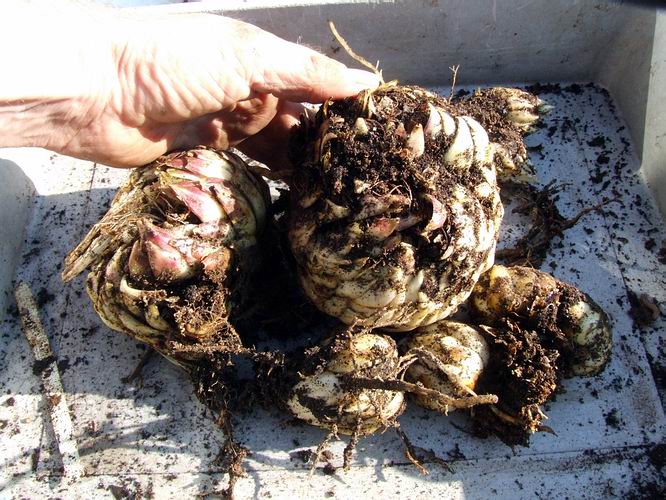
Large lily bulb
On a happier note I was lifting and shifting some of our lily bulbs and found this giant, that would feed an army, surrounded by a number of offspring. Each of the smaller bulbs, smaller relative to that monster parent bulb that is, are all flowering sized and will flower next summer.
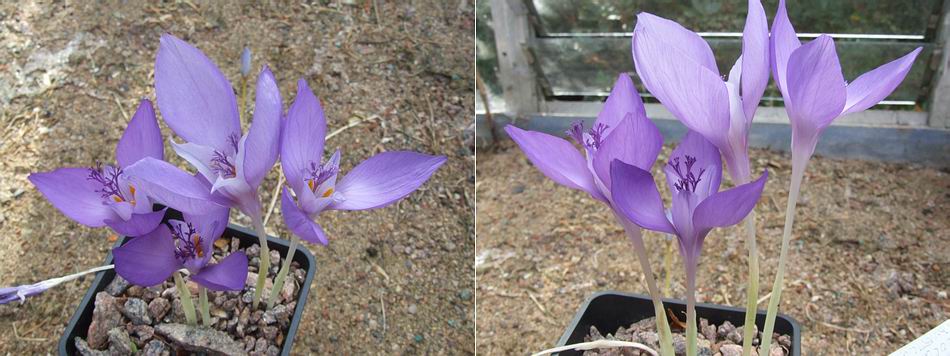
Crocus banaticus
It is crocus time now and this is a pot of Crocus banaticus raised from seeds collect in the mountains of Romania. There is some variation in the colours and all are excellent plants.
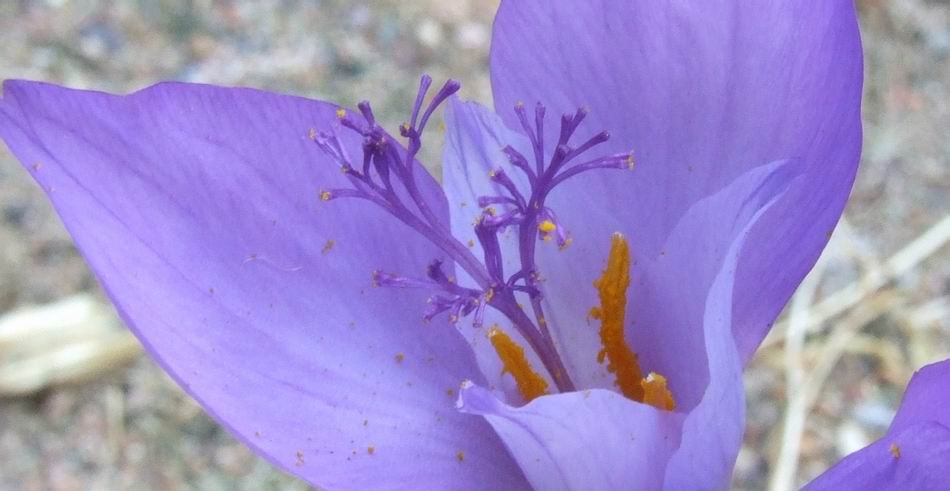
Pollen on stigma
To ensure that I can perpetuate this collection I was out there with my paint brush pollinating several times over the flowering period until I could see that the stigmas were receptive. Often the pollen ripens days before the stigma is mature so you have to transfer pollen several times until you see the pollen sticking onto the ends of the filaments where the stigmas are located, as you can see in the close up picture above.
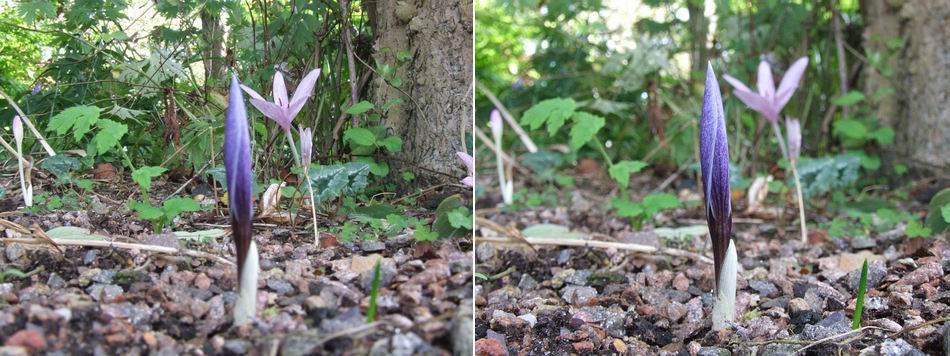
Focusing on crocus
Now that old problem we face when using auto focus cameras which cannot tell what we want to focus on. On the left the camera focused perfectly on the background, leaving the subject of the crocus flower in bud, blurry. On the right I used the manual focus setting and reversed the camera's decision by making the crocus sharp and the back ground fuzzy. If you do not have a manual focus option you can get a similar result by pointing the camera at ground at the base of the flower pushing the button down half way to lock the focus then holding it there realign the camera and then take the picture. Another method is to place your hand just in front of the crocus lock the focus on your hand then remove your hand and take the picture taking care not to move the camera.
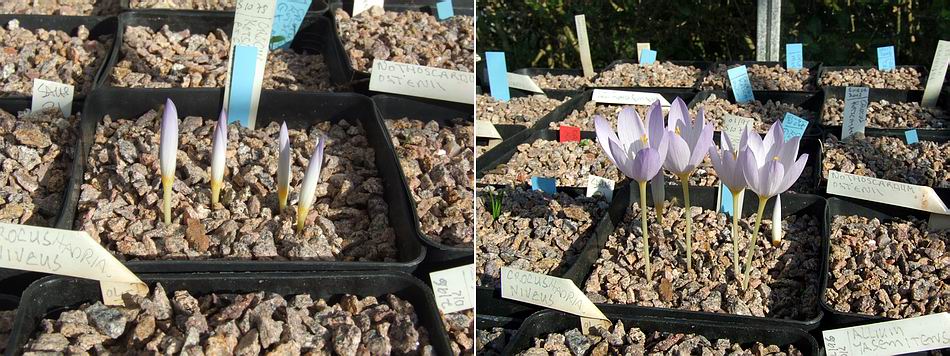
Crocus kotschyanus 12 hours apart
I never cease to be amazed just how fast the autumn crocs can come through and flower. One day there was no sign at all of these Crocus kotschyanus, next day the buds had appeared then12 hours later they are in full flower.
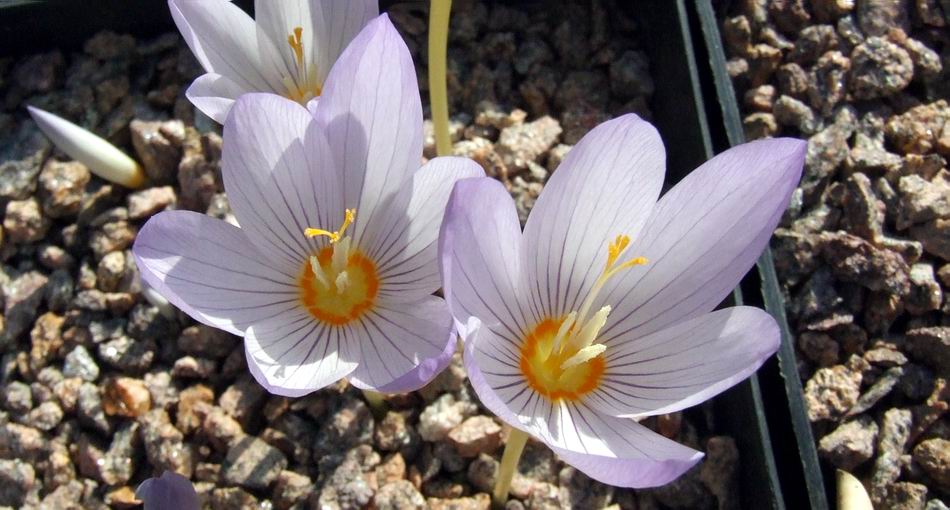
Crocus kotschyanus flowers
Looking inside of the very beautiful flowers of Crocus kotschyanus you can see the dramatic markings and the white pollen.
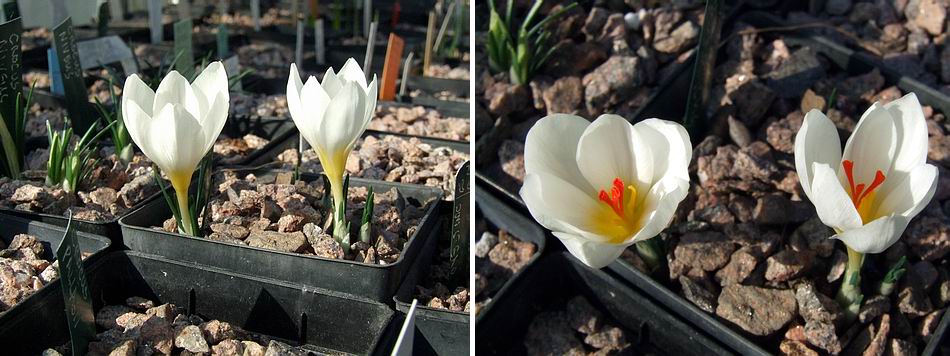
Crocus hadriaticus
Plenty of crocus are shooting up now, like these Crocus hadriaticus, as we are enjoying some lovely bright sunny days which pushes the bulb house temperatures into the 20's. It is interesting that while it would appear to be the drop in temperature that stimulates the root growth, it seems to be the heat that encourages the flowers to shoot up - another mystery of the bulb world for us to crack.
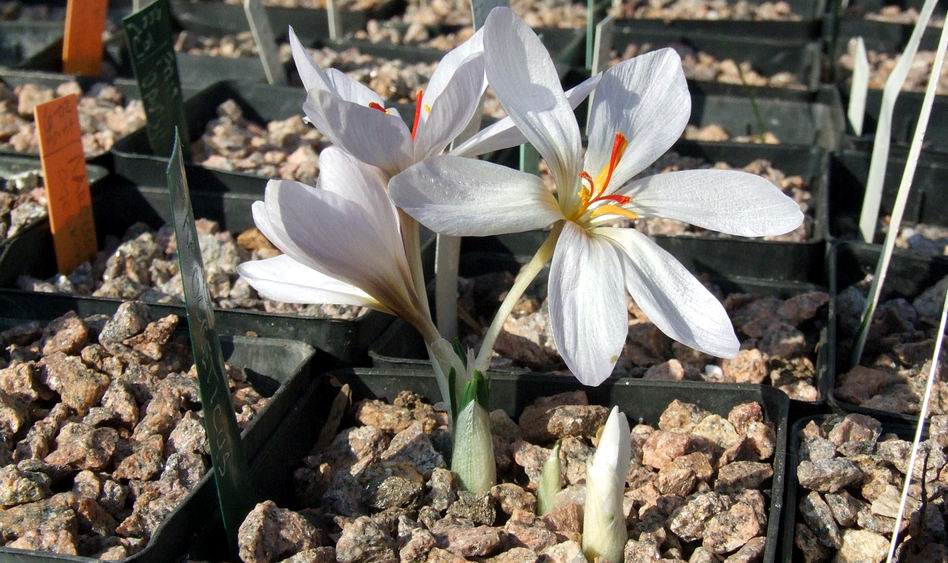
Crocus oreocreticus
Crocus oreocreticus with several flowers from each corm is a great beauty with a very interesting scent. It is well worth poking your nose into your crocus flowers as there is usually a delightful reward waiting in the form of perfume.
Regarding the Bulb Log index, Len has updated the file and added a printer friendly version that will print out a nice A5 booklet with double sided printing. If your printer does double sided printing select flip along short edge, if not print the sheets individually turning them end for end to achieve double sided pages.
^ back to the top ^
|

